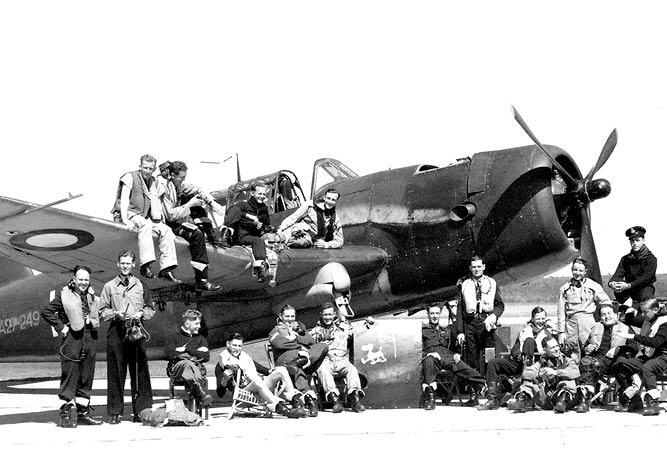by Charles Page
The Vultee Vengeance was arguably one of the finest dive bombers of its time, but was unfairly maligned due to early problems and spectacular accidents. Yet, many crews, including pilot Alan Place of No. 25 Squadron, regarded it with respect, and even affection: ‘My love affair with the Vultee Vengeance began one sunny morning in May 1943 at No. 7 SFTS, Deniliquin, NSW, where I was about to graduate as a pilot. It had been announced that two Vengeances from No. 4 OTU, Williamtown, would put on a flying display, and the entire senior course was to be on the tarmac at the appointed hour.
Rumour had it that the purpose of the visit was to recruit volunteers from the graduating pilots for the big dive-bombers. Quite apart from the natural tendency of young pilots to prefer the glamour of fighters, virtually none had been including the Vengeance when asked to list their choices in flying duties. For most trainees the Vengeance was bad news – an aeroplane with a fearsome reputation for killing crews in spectacular crashes.
So it was that sixty-odd of us watched the two aircraft sweep in from the north at 10,000 feet and wing over into a vertical dive on the aerodrome. They came down silently with their magnificent air brakes holding them steadily on about 290 mph. Suddenly they were upon us, retracting their brakes at 2500 feet and commencing the pull-out. They flashed overhead at near 500 mph and the sound burst upon us like a thunderclap. With a tremendous roar they completed upward slow rolls and banked steeply into the circuit area. I was impressed.
Then came the fast turning approach and landing. As the two Vengeances taxied towards us, the big Wright Cyclone engines growling with their rough, throaty beat, I knew I had fallen for this aeroplane. It looked strong and aggressive. The Spitfires and Kittyhawks of my aspirations were far away. These bellicose machines were here in the flesh, thundering and vibrant with power. There was no doubt about my choice now.’
Despite Alan Place’s enthusiasm, the Vengeance had received some bad publicity. Perhaps the greatest single factor to give the Vengeance a bad name was an accident that occurred during a demonstration at Flemington racecourse in Melbourne on 4 September 1943. After a simulated dive-bombing attack, the pilot attempted a climbing roll, but after rolling through 180 degrees, the nose of the Vengeance dropped alarmingly.
The aircraft failed to recover, flying so low it barely cleared a train at Macaulay railway station, and a woman cycling nearby fell off her bike. The aircraft then dived inverted into a grain store, ripping through the roof and two brick walls before exploding into flames, and killing the two airmen instantly. The accident was viewed by 60,000 people and the incident was widely reported in the press. Fortunately, no one was in the grain store at the time and two cats, kept there to control mice, somehow survived.
The Vultee Vengeance was originally ordered in June 1940, when the British awarded a contract for a dive-bomber to the American company, Vultee Aircraft. An initial order was placed for 700 aircraft. The prototype Vengeance was produced at Vultee’s plant in Downey, California and made its first flight on 22 July 1941. Vultee sub-contracted the Vengeance MkI to Northrop Aircraft, while Vultee produced the Mk. II and Mk IV versions at Nashville. Because the Mk. IV had the dive brakes wired shut, and a wing incidence of four degrees, it could not make a vertical dive. However, it was a more stable gun platform, lighter on the controls, and had improved forward visibility.
A most important design innovation of the MkI was the zero angle of wing incidence, which gave the aircraft a ninety-degree vertical dive ability. Most aircraft had the wing set into the fuselage at an angle of three to four degrees, to give the required lift. However, the Vengeance was forced to fly with a nose-up attitude in order to generate enough lift. This resulted in reduced forward visibility for the crew. There was also a danger that the navigator, in the rear cockpit, could impact the tail if he bailed out. However, pilots were aware they would need to invert the aircraft, before bailing out.
The Vengeance had a distinctive ‘crank’ shaped wing. The centre wing section was sharply swept back at its leading edge, while the outer wing panels were angled upwards. The dive brakes or ‘toast racks’ above and below the wings were slotted to reduce buffeting.
The RAAF acquired the Vengeance almost by accident. The requirement for a Wirraway replacement led to an order for Brewster Bermuda dive-bombers, but when production was delayed, the British Air Mission in America diverted RAF Vengeances to the RAAF. By 1942 some 400 Vengeances were on order for the RAAF, although only 342 were actually received. The first Vengeance squadron formed was No. 12, followed by Nos. 21, 23, 24 and 25 (City of Perth), which were all equipped by July 1943.
A somewhat unusual and fatal accident occurred to a No. 25 Squadron Vengeance, which dived into a hill north of Pearce. It was believed the control stick broke off in the pilot’s hand. On another occasion, the control stick broke off at the first bend, but the pilot was able to land by putting his thumb inside the broken control stick, and also using the elevator trim. Accidents were also caused by elevator fabric ripping off in the dive. As a result, all Vengeances had their elevators reinforced with an extra layer of fabric.
Despite these problems, the Vengeance gave a good account of itself in operations with the RAAF. The first action occurred on 18 June 1943 when twelve aircraft of No. 12 Squadron made a dive-bombing attack on Selaru Island, 200 miles north of Darwin. The squadron, led by Flt. Lt. Cyril McPherson and Flt. Lt. Barry Keys, put every bomb on target. Flt. Sgt. Lester, who was on the raid, commented, ‘For a long time our dive-bomber crews thought they would continue as a spare part to be used only if there was an invasion of Australia. Now it has been demonstrated that they can do a big job well.’
The only sustained dive-bombing campaign began in January 1944, when No. 21, 23 and 24 Squadrons arrived at Nadzab in the Markham Valley of northern New Guinea. Morale was high in the squadrons during the New Guinea campaign; particularly in No. 24 Squadron because of all the support and mail they received from the ‘Tivoli’ dancing girls in Sydney. For seven weeks dive-bombing attacks were made, with minimal loss, against Japanese airfields, supply and ammunition dumps. The Vengeances were particularly effective in the heavy fighting for Shaggy Ridge, and on 31 January 1944 they totally destroyed the Gori River Bridge and its nearby gun emplacements. The Australian Army was highly appreciative of the close support provided and the exceptional bombing accuracy. One army message to the Vengeance squadrons read, ‘Ground sources report your bombing a bull’s eye. Bloody good show.’
In operations, the Vengeance was surely the most accurate of dive-bombers. In a demonstration for army staff, Cyril McPherson made a direct hit on a white-painted anthill, diving from 12,000 feet. Bombing accuracy was made easier by the 90-degree vertical dive of the Vengeance, which allowed for pinpoint aiming. An additional benefit of the 90-degree dive was that the Japanese anti-aircraft guns could only elevate to 80 degrees. Most dive-bombers had much shallower dive angles — between 60 and 75 degrees, and even the legendary German Stuka only achieved a 72-degree dive.
For all their success, the Vengeance squadrons required fighter escort and also took up airfield space that the Americans needed for their Lightning fighters and other newer aircraft. For these reasons, General Kenney ordered the Australian Vengeances home on 8 March 1944. The concept of a dedicated dive-bomber now seemed outmoded. However, No. 12 Squadron, based at Merauke, was not affected by this order and stayed on until 9 June 1944.
As historian George Odgers recalled, ‘When the three Vengeance squadrons received the word that they were to return to Australia they held the party to end all parties. They had embarked for New Guinea fully equipped for a much longer stay and all aircraft were loaded with the necessities of life (whisky, rum, gin, wine, etc.).’
The RAAF, on receiving Kenney’s decision cancelled the last fifty-eight aircraft in the Vengeance order and Vultee phased out the Vengeance program in May 1944. Production totalled 1539 Vengeance dive-bombers of all variants.
One of the Vengeance’s strongest proponents was the RAAF’s highest time Vengeance pilot, Flt. Lt. Cyril ‘Mac’ McPherson, who logged 603 hours on the type. Unbelievably, McPherson was initially turned down by RAAF medical staff because of dandruff. However, after suitable treatment he passed another medical examination and commenced pilot training.
McPherson was graded an above average pilot and joined No. 12 Squadron, flying Wirraways out of Batchelor Field, Darwin. On one flight, in September 1942, Pilot Officer McPherson and his navigator Flt. Sgt. Taylor were detailed to drop supplies to a Kittyhawk pilot who had forced landed on Melville Island. It was not until 1993 that McPherson found he had taken part in the rescue of John Gorton, who became prime minister of Australia from 1968 to 1971.
Later in 1942, Cyril McPherson, knowing his wife was expecting a baby, confidently predicted a girl. Even before his daughter was born, he had her chosen name ‘Dianne’ painted on the nose of Vengeance A27-209. McPherson received the news of his daughter’s birth by way of a carefully worded signal sent through official channels: ‘Fittings female hydraulic pumps, delivered safely August 3rd 1943.’
Shortly afterwards, the squadron received the news it was to move from Cooktown, Queensland to Merauke, New Guinea. It was quickly realised there would be no ‘grog’ available there and it fell to McPherson to make the arrangements. A diversion was made to Cairns, and an enormous quantity of beer, gin and whisky was duly purchased and loaded carefully into the bomb bays of six Vengeances. However, one pilot inadvertently selected the bomb bay doors open, with catastrophic results. His entire load of grog was dropped onto the tarmac. At that moment, the tower advised that they had fifteen minutes to clean up the mess, as the Chief of Air Staff would shortly be arriving in a Hudson bomber. The crews, now under enormous pressure, managed to reload the grog in time, and amazingly not one bottle was broken.
After over 600 hours flying the Vengeance, Cyril McPherson had nothing but praise: ‘The unfortunate impression that seems to have existed, that the Vengeances were dangerous and unsafe, was in my opinion, completely unfounded. In all respects it was an extremely stable aircraft and although its all up weight was in the region of 13,000 pounds, it was fully aerobatic. On landing, even in a strong crosswind, it showed no tendency to swing or to ground loop. Though the controls were heavy, they most certainly were not sloppy. In fact they were very positive, with the result that the Vengeance was remarkably manoeuvrable; I would suggest more so than any other aircraft of its weight and size at that time.’
McPherson found the Vengeance viceless and impossible to spin, ‘It would just go into a spiral dive and when you centralised the controls it would come straight out.’ Also, at heights up to 6000 feet, the Vengeance could easily stay on a Kittyhawk’s tail, provided the Kittyhawk did not go into a climb.
Vengeance pilot John Barraclough, of No. 7 Communications Unit Pearce, fell in love with the aeroplane. Barraclough had achieved an ‘A’ grading, the highest pilot standard possible in the RAAF. He flew a wide variety of aircraft, including the Tiger Moth, Spitfire and Lancaster, but declared that the Vengeance was the most desirable aircraft he ever flew, and felt absolutely smooth to fly: ‘Flying it was sheer pleasure. I became more confident and executed some barrel rolls, and then rushing upwards, did some slow rolls towards the sky, through white puffy clouds. It was exhilarating. I felt as one with the machine. We’d become friends. It was love at first sight.’
Sources: Alan Place, Cyril McPherson, John Barraclough, George Odgers, Peter Smith NAA, Patrick Ferry
image No. 25 Squadron crews at Pearce, with Vengeance A27-249. This aircraft crashed at the gunnery range on 28 March 1944. Both crew were killed. Aviation Heritage Museum of WA













